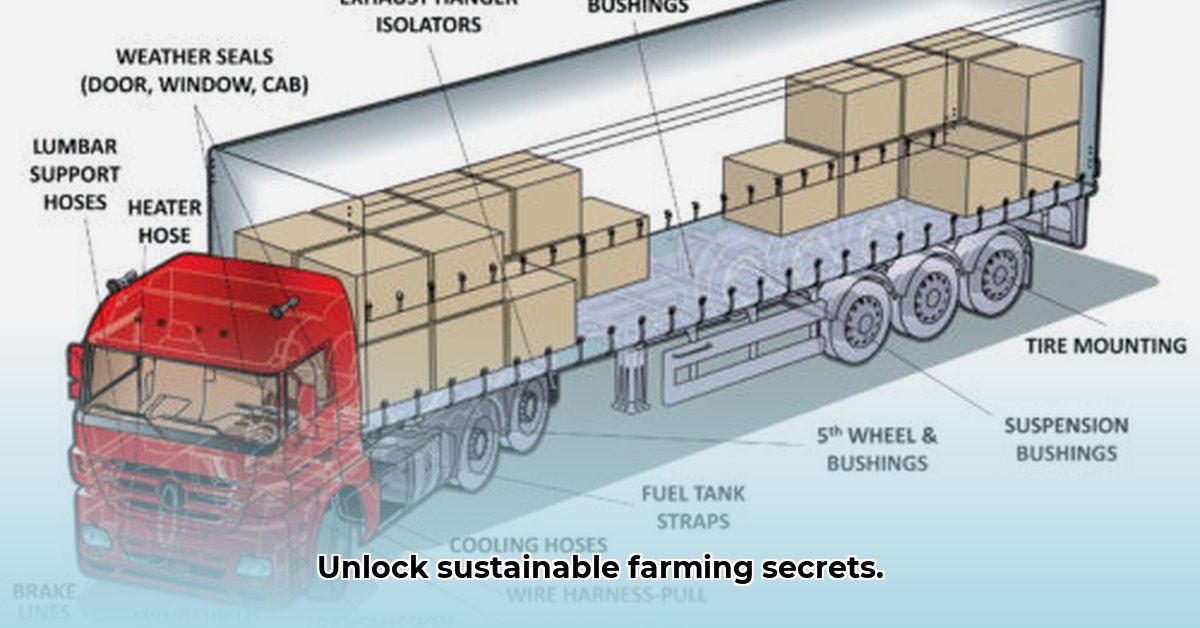
Anatomy of a Tractor-Trailer: Understanding the Machine Behind Sustainable Farming
Ever wonder what's really going on beneath the hood of that massive rig hauling your crops? Understanding the intricacies of a tractor-trailer isn't just for mechanics; it's a crucial element of sustainable farming. Fuel efficiency, soil health, and safety all hinge on your knowledge of this critical piece of equipment. This guide demystifies the key components, explaining how understanding them can save you money, protect the land, and increase your farm's profitability. For more on the tractor's impact on agriculture, check out this helpful resource: Tractor's Impact.
The Tractor: The Powerhouse of Your Operation
The tractor is the driving force, providing the power to pull the load. Its engine, typically a powerful diesel engine (often a six-cylinder or larger), is where the action begins. Here's where sustainability comes into play: fuel efficiency is paramount. Regular maintenance—think timely oil changes and filter replacements—significantly impacts fuel consumption. A well-maintained tractor directly impacts your bottom line and reduces your environmental footprint – a win-win situation.
The transmission, which connects the engine to the wheels, manages power transfer. Some transmissions, like direct-drive systems, are designed for better fuel economy. The differential then distributes power between the drive wheels, ensuring traction even on uneven terrain. This is essential for reliable transportation of your goods to market, regardless of conditions. Don't underestimate the importance of these components; efficient power transfer is crucial for both profitability and environmental responsibility.
The Trailer: Safely Carrying Your Crop
The trailer is where your harvest resides. Various types exist, each suited for different cargo: flatbeds for equipment or lumber, refrigerated trailers (reefers) for perishable goods, and tankers for liquids like milk or grain. Selecting the appropriate trailer type is crucial for optimal fuel efficiency and streamlined transportation.
Proper loading is paramount. Uneven weight distribution increases fuel consumption, accelerates tire and brake wear, and raises safety risks. Think of it like balancing a seesaw – uneven weight creates imbalance and inefficiency. Speaking of brakes, these are critical safety components. Most tractor-trailers utilize air brakes, requiring regular maintenance to prevent accidents. Brake failure can halt operations, potentially causing significant financial losses and safety hazards. Does regular brake inspection increase your operational safety? Yes, significantly.
Tires: The Unsung Heroes of Fuel Efficiency and Soil Health
Tractor-trailer tires are often overlooked, yet they significantly influence fuel economy and environmental responsibility. Correct tire inflation is essential for sustainable practices. Under-inflation increases rolling resistance, wasting fuel and compacting the soil. Over-inflation stresses the tires and reduces traction. Utilizing tires appropriate for varying soil conditions is key; Low Ground Pressure (LGP) tires, for instance, minimize soil compaction. Tire wear also affects fuel economy; worn tires increase resistance, leading to higher fuel consumption. How much fuel do you think you could save with optimized tire pressure and maintenance? It's a substantial amount.
Maintenance: The Cornerstone of Sustainable Farming
Regular maintenance isn't just about keeping your rig operational; it's a fundamental aspect of sustainable farming. This involves routine inspections, prompt repairs, and timely part replacements. Proper lubrication is also vital for minimizing wear and tear, ensuring smooth and efficient operation. Think of it as preventive medicine for your machinery. A well-maintained rig extends its lifespan, saves on repair costs, reduces waste, and significantly lessens your environmental impact.
Key Components and Their Impact on Sustainability
| Component | Impact on Sustainability | Maintenance Considerations |
|---|---|---|
| Engine | Fuel efficiency, emissions | Regular oil changes, filter replacements, tune-ups |
| Transmission | Fuel efficiency, smooth power delivery | Fluid checks, adjustments |
| Tires | Fuel efficiency, soil compaction, traction | Proper inflation, tread depth checks, regular rotations |
| Braking System | Safety, cost of maintenance | Regular inspections, air pressure checks, brake pad replacements |
| Trailer Design | Cargo capacity, fuel efficiency | Regular inspections, structural integrity checks |
Understanding the interplay of these components is crucial for efficient and sustainable farming. It’s about making informed decisions that impact fuel consumption, soil health, and profitability. Each part plays a vital role in creating an environmentally and economically responsible agricultural operation. Remember, sustainable farming isn't just a trend; it’s a responsible way of life.